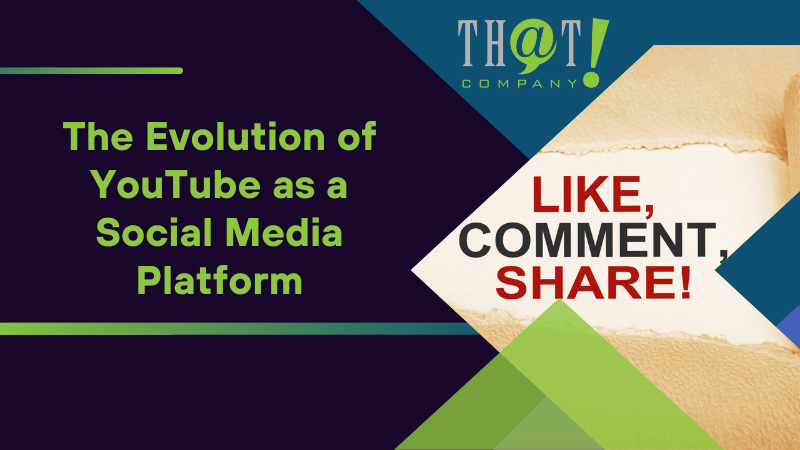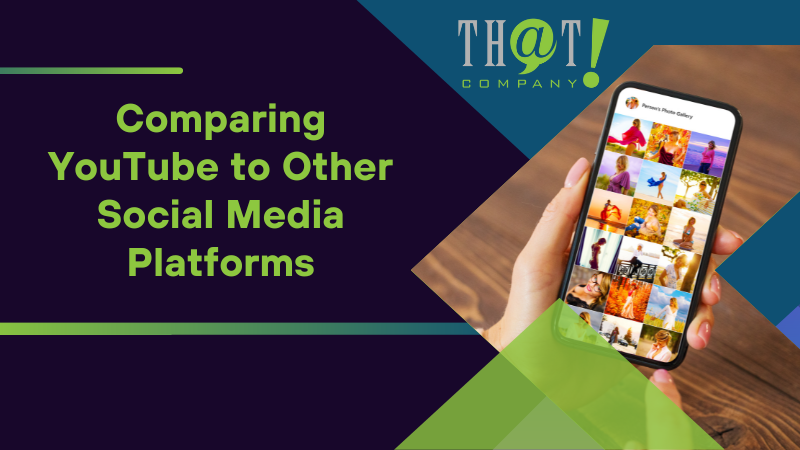
Is YouTube social media? This question has sparked debates ever since the platform’s inception. Join us as we dive into a thorough exploration of YouTube’s journey, evolution, and its place in the social media landscape. Get ready to discover the ins and outs of this powerful platform.
Explore the details of this powerful platform with the help of our social media management company. And if you’re curious about white label branding services, we’re here to provide you with all the information you need. Get ready to dive into the fascinating world of YouTube like never before!
Short Summary
YouTube is a popular social media platform that allows users to share and access video content, as well as having key features such as user-generated content, interaction, personalization & networking.
YouTube facilitates communication & open dialogue between users to build relationships & form communities with people who share their interests.
Leverage the potential of YouTube for businesses by creating engaging content, optimizing titles/thumbnails and interacting with viewers.

Defining Social Media: Where YouTube Fits In
Social media platforms, including popular social media platforms and social media sites, come in various shapes and sizes, but they all share some key features for managing social media accounts and catering to social media users.
Interaction
Personalization
Networking
The potential for going viral
YouTube, initially a video-sharing platform, has grown to become a youtube social media giant, with 2.2 billion active users each month.
YouTube is a platform for sharing and accessing video content. This accessibility makes it a highly social media platform. Let’s break down its defining characteristics.
Let’s break down the defining characteristics of this popular platform and how it plays into white label digital advertising strategies.
Communication and Interaction
YouTube thrives on communication and interaction. Users can leave comments, like videos, and subscribe to channels to connect with content creators and other users. Sharing information, ideas, and messages is at the heart of social media, and YouTube is no exception. This popular social media site has become a hub for connecting with a wider audience and fostering open dialogue. It is a platform for users to express themselves, engage with others, and build relationships.
Building Communities
Community building is another essential aspect of YouTube as a social media platform. Creators can develop their own YouTube channels, upload videos, and interact with their audience, fostering a sense of community. The ability to subscribe to channels allows creators to attract like-minded people, turning YouTube into a thriving social media network where communities can grow around shared interests.
YouTube provides a unique platform for creators to build relationships with their audience, creating a sense of community.

The Evolution of YouTube as a Social Media Platform
Since its launch in 2005, YouTube has come a long way, evolving from a simple video-sharing site to a full-fledged social media platform. Its growth was fueled by the rising popularity of video sharing and the introduction of new features that encouraged user engagement and interaction.
Let’s dive into the early years and the milestones that shaped YouTube’s transformation into a social media powerhouse.
Early Years and Growth
In its early days, YouTube focused on providing a platform for users to share videos. As the platform grew, YouTube introduced features like comments, likes, and subscriptions, which allowed users to connect with each other and create communities.
This shift in focus towards social interaction is what makes YouTube social media, playing a significant role in transforming YouTube into the social media platform we know today.
Introduction of Social Features
The introduction of social features on YouTube, such as:
Comments
Likes
Subscriptions
Community tab
Allowed users to engage with content and creators on the platform. Moreover, the community tab enabled creators to share updates, live videos, and interact with their audience through text posts, images, and GIFs. These features not only made YouTube more interactive but also solidified its position as a social media platform.
The community tab has been a great success, allowing users to connect with their favorite creators and engage with them.

Key Social Aspects of YouTube
User-generated content, engagement and interaction, influencers, and community building are the three key pillars of YouTube’s social aspects. These elements are not only crucial for the platform’s success but also contribute to its distinctive identity as a social media platform.
Let’s delve deeper into each of these aspects and explore their significance.
User-Generated Content
At the core of YouTube lies its user-generated content, which allows anyone to upload and share videos with a global audience. Some examples of the diverse user-generated content YouTube offers include:
Beauty tutorials
Gaming walkthroughs
Cooking demonstrations
Music covers
Comedy sketches
Educational videos
YouTube is a treasure trove of diverse content that caters to a wide range of interests and hobbies, including music videos and YouTube videos.
This democratization of content creation not only fuels YouTube’s popularity but also sets it apart from traditional media outlets.
Engagement and Interaction
YouTube encourages engagement and interaction through features like comments, likes, and subscriptions. These features enable users to actively participate in discussions, share their opinions, and connect with other users and creators.
This high level of engagement and interaction is integral to the platform’s success and its identity as a social media platform.
Influencers and Community Building
Influencers play a crucial role in YouTube’s social media landscape. These content creators have amassed large followings and have become experts in their respective fields. By engaging with their audience and collaborating with other influencers and brands, these creators build communities around their content, further solidifying YouTube’s social media status.
Influencers are an integral part of YouTube’s success, and their presence is important.

Comparing YouTube to Other Social Media Platforms
While YouTube shares many similarities with other social media platforms like Facebook, Instagram, and TikTok, it also boasts unique features that set it apart. In this section, we will compare YouTube to these platforms, highlighting the differences and similarities in terms of content, engagement, and audience preferences.
YouTube content is typically longer-form than on other platforms, with videos ranging from a short film to a full movie.
YouTube vs. Facebook
Both YouTube and Facebook focus on user-generated content and engagement. However, YouTube primarily revolves around video content, while Facebook offers a wider variety of content and activities.
Additionally, YouTube provides a robust analytics platform for creators to monitor their viewership, which Facebook lacks.
YouTube vs. Instagram
Instagram and YouTube both have influencer communities, but their content focus differs. Instagram emphasizes images and short videos, while YouTube offers long-form video content. This distinction caters to different audience preferences and content consumption habits, setting YouTube apart as a unique social media platform.
The visual nature of Instagram makes it a great platform for influencers to showcase their creativity.
YouTube vs. TikTok
TikTok and YouTube both prioritize video content, but their formats and audiences differ. TikTok’s short-form videos appeal to a younger demographic and encourage quick content consumption. In contrast, YouTube’s longer videos cater to a broader audience, providing more in-depth content and a greater variety of topics.

Leveraging YouTube as a Social Media Platform for Business
Businesses can harness the power of YouTube as a social media platform by creating engaging content, optimizing titles and thumbnails, and interacting with viewers. By tapping into these strategies, businesses can build their online presence, reach a wider audience, and foster loyalty among their followers.
Let’s explore how to effectively leverage YouTube for your business.
Creating Engaging Content
To succeed on YouTube, businesses should:
Create content that appeals to their target audience
Produce captivating visuals
Tell compelling stories
Provide valuable information that resonates with viewers
Publish video content consistently
This will encourage engagement and help businesses achieve their goals on the platform.
By focusing on creating high-quality content, businesses can attract and retain a loyal audience on the platform.
Optimizing Titles and Thumbnails
An often overlooked aspect of YouTube’s success is optimizing video titles and thumbnails. By crafting attention-grabbing titles and visually appealing thumbnails, businesses can attract more viewers and improve visibility on the platform.
Additionally, incorporating relevant keywords and hashtags can further boost discoverability and engagement.
Interacting with Viewers
Building relationships with viewers is essential for businesses on YouTube. By engaging with viewers through comments, likes, and shares, businesses can foster loyalty and strengthen customer relationships. This interaction not only humanizes the brand but also helps businesses gain valuable insights into their audience’s preferences and needs.
Creating a strong bond with viewers is essential for businesses on YouTube, through comments, likes, and shares.

The Future of YouTube as a Social Media Platform
The future of YouTube as a social media platform will depend on its ability to:
Compete with other platforms
Adapt to changing user preferences
Continuously innovate
Address the needs of its users
By doing so, YouTube can maintain its position as a dominant force in the world of social media.
Let’s examine the challenges and opportunities that lie ahead for YouTube.
Competing with Other Platforms
To maintain its position in the market, YouTube must continue to innovate and compete with other social media platforms. This involves introducing new features, providing a better user experience, and helping creators monetize their content.
By staying ahead of the competition, YouTube can retain its unique identity and remain a popular choice for users and creators alike.
Adapting to Changing User Preferences
As user preferences change, YouTube will need to adapt its features and offerings to stay relevant and appealing to its audience. This may involve introducing new tools that allow users to customize their experience, control their privacy settings, and personalize their ad preferences.
By staying in tune with its users’ needs, YouTube can ensure its continued success in the ever-evolving social media landscape.
Summary
In conclusion, YouTube’s journey as a social media platform is a testament to its adaptability, innovation, and user-focused approach. By embracing its social aspects and continuously evolving to meet the needs of its users, YouTube has secured its place as a powerful force in the world of social media. As we look to the future, one thing is clear: YouTube will continue to shape the way we connect, share, and engage with the world around us.

Frequently Asked Questions
Is YouTube a social media or what?
Yes, YouTube is a social media platform with many similarities to traditional platforms like Facebook and Twitter. It allows you to share content, interact with others, and build a community.
Why YouTube is not a social media?
YouTube is not a social media platform since it functions more like a User Generated TV station with ads, rather than a traditional social network with engaging features.
It does not have the same features as other social media platforms such as commenting, liking, and sharing. It is more focused on providing content for viewers to watch and engage with.
What is considered social media?
Social media is a collective term for websites and applications that focus on communication, community-based input, interaction, content-sharing, and collaboration. It includes blogs, micro-blogs, wikis, social networking sites, photo-sharing sites, instant messaging, video-sharing sites, podcasts, widgets, virtual worlds, and more.
People use social media to stay in touch and interact with friends, family, and various communities.
How can creators build communities on YouTube?
Engage with viewers, respond to comments, and create content that resonates with the audience – these are the steps creators can take to build a community on YouTube.
How can businesses leverage YouTube as a social media platform?
Businesses can use YouTube to create engaging content, optimize titles and thumbnails, and interact with their viewers, helping them boost their reach and presence.
By taking advantage of the platform’s features, businesses can create content that resonates with their target audience and increase their visibility. They can also use YouTube to build relationships with their viewers, respond to comments, and create a community around their brand.



























 Talk With Us
Talk With Us  Give Some Love
Give Some Love 


